Aiding the translation process with affixal analyis – A case study in “the old man and the sea”
Affixes have been of a great interest, attracting more and more translators’ attention. While
English is an inflectional language, Vietnamese is an analytical one. This morphological difference
requires translators to invest more time for the translation process and affects the quality of the
translation. This study examines the semantic contribution of English suffixes and prefixes in the
translation process by categorizing and analyzing various English affixes in the source texts and
proposing their Vietnamese equivalent for the target texts. The results reveal that implementing an
affixal analysis in the translation process (1) enhances the translation quality, (2) accelerates the
translation process, and (3) conveys patterns of meaning associated with affixal stress and
intonation. These findings yield practical translation practices, thereby ensuring the equivalence and
consistency in English–Vietnamese translation.
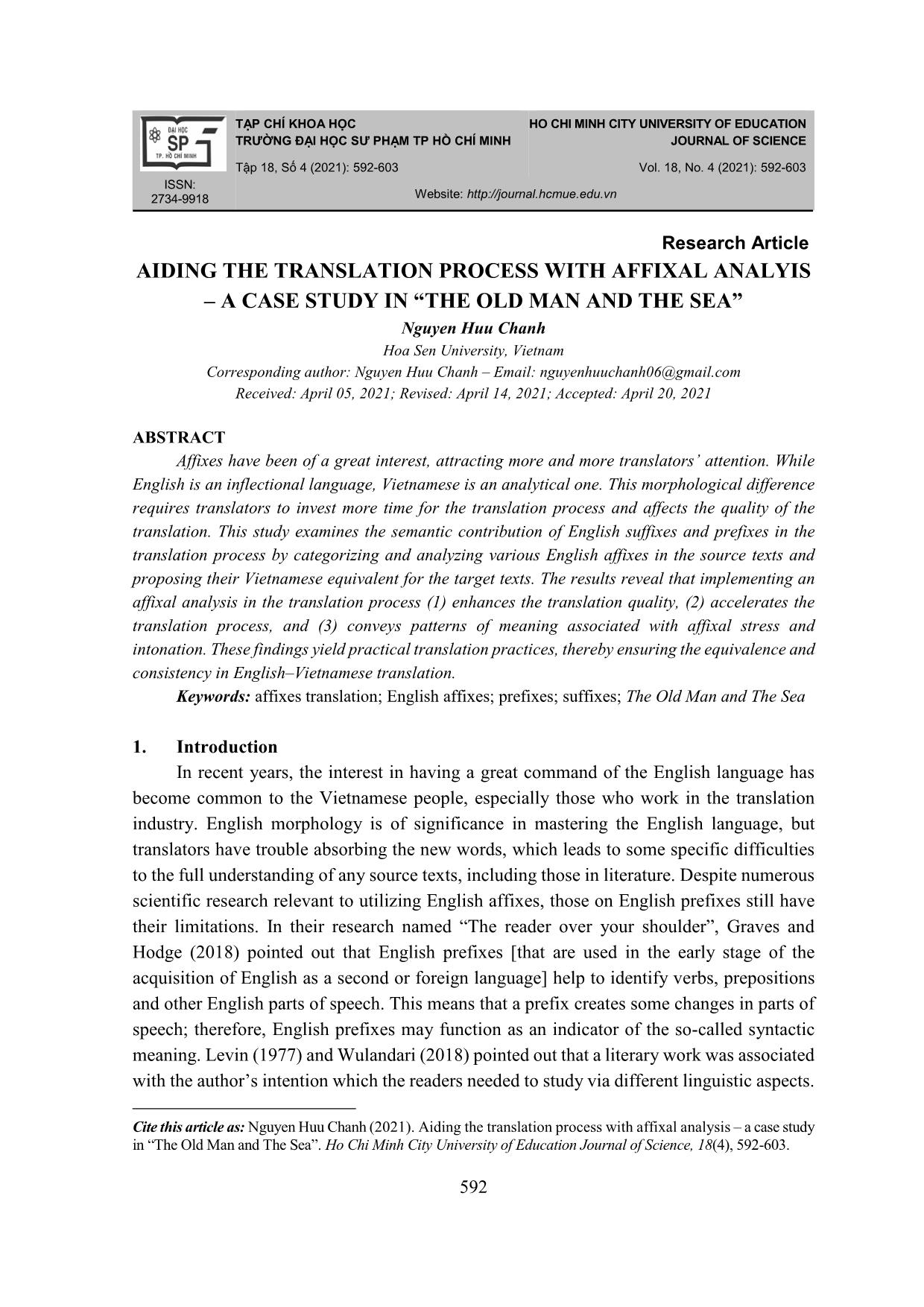
Trang 1
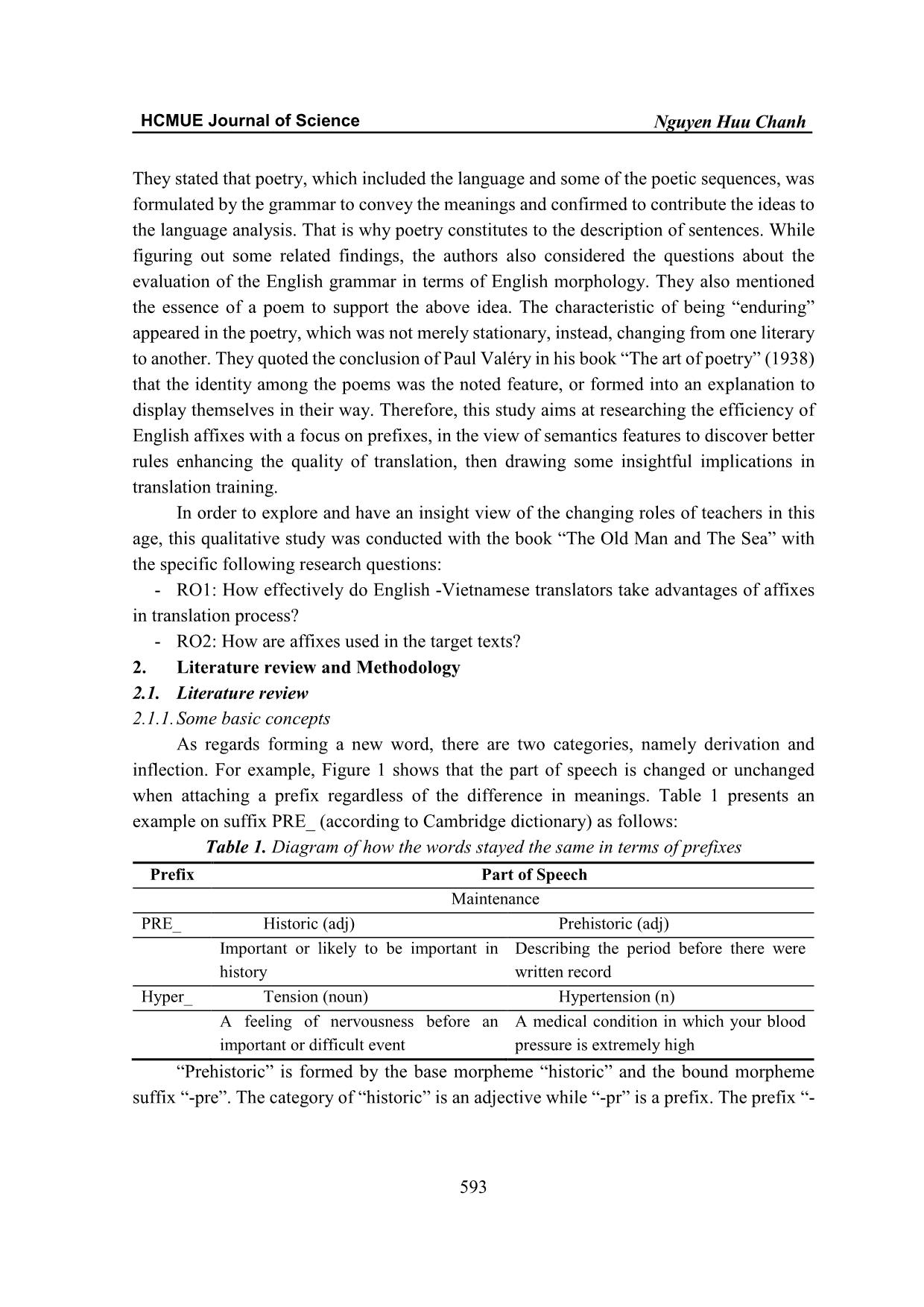
Trang 2
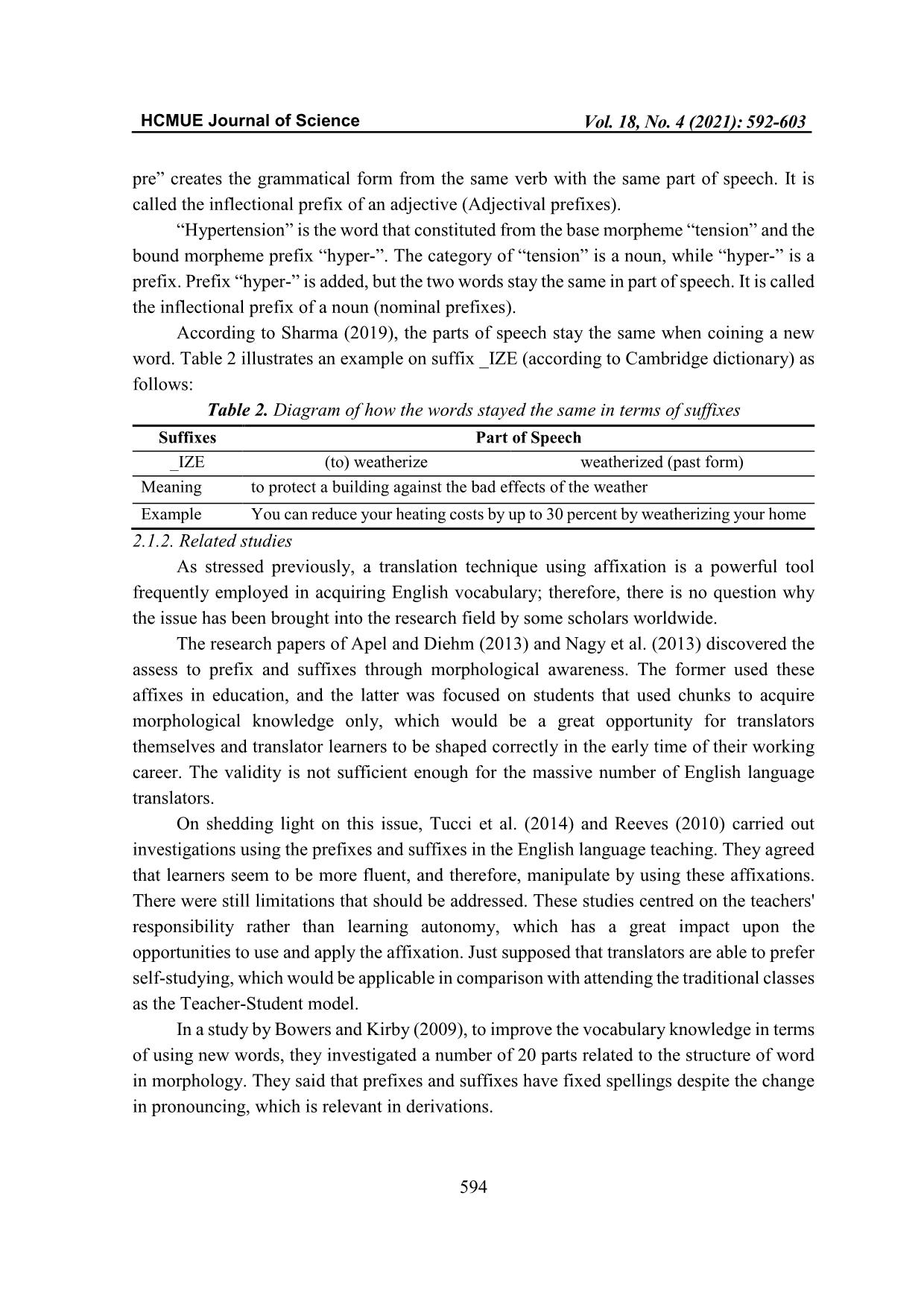
Trang 3
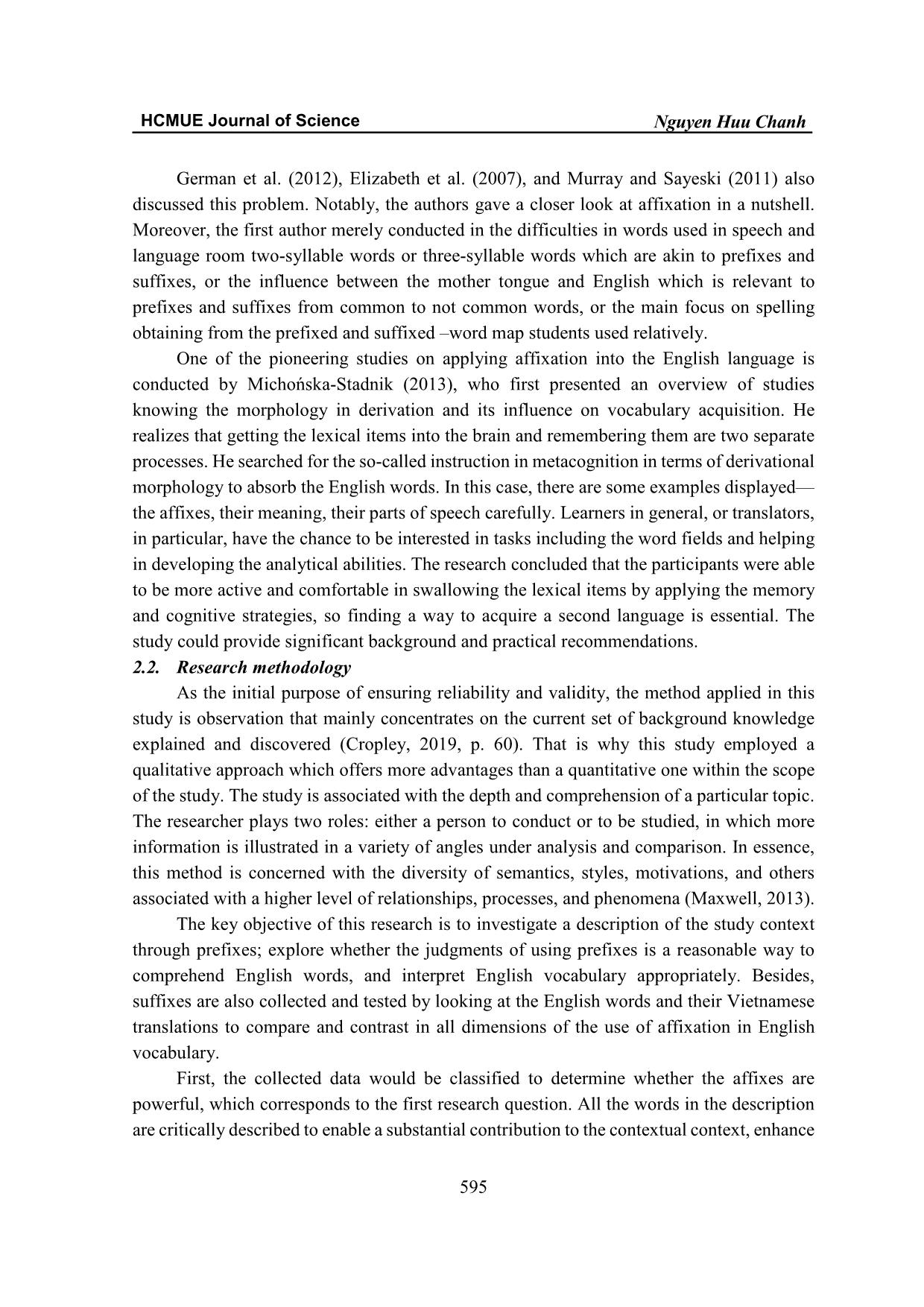
Trang 4
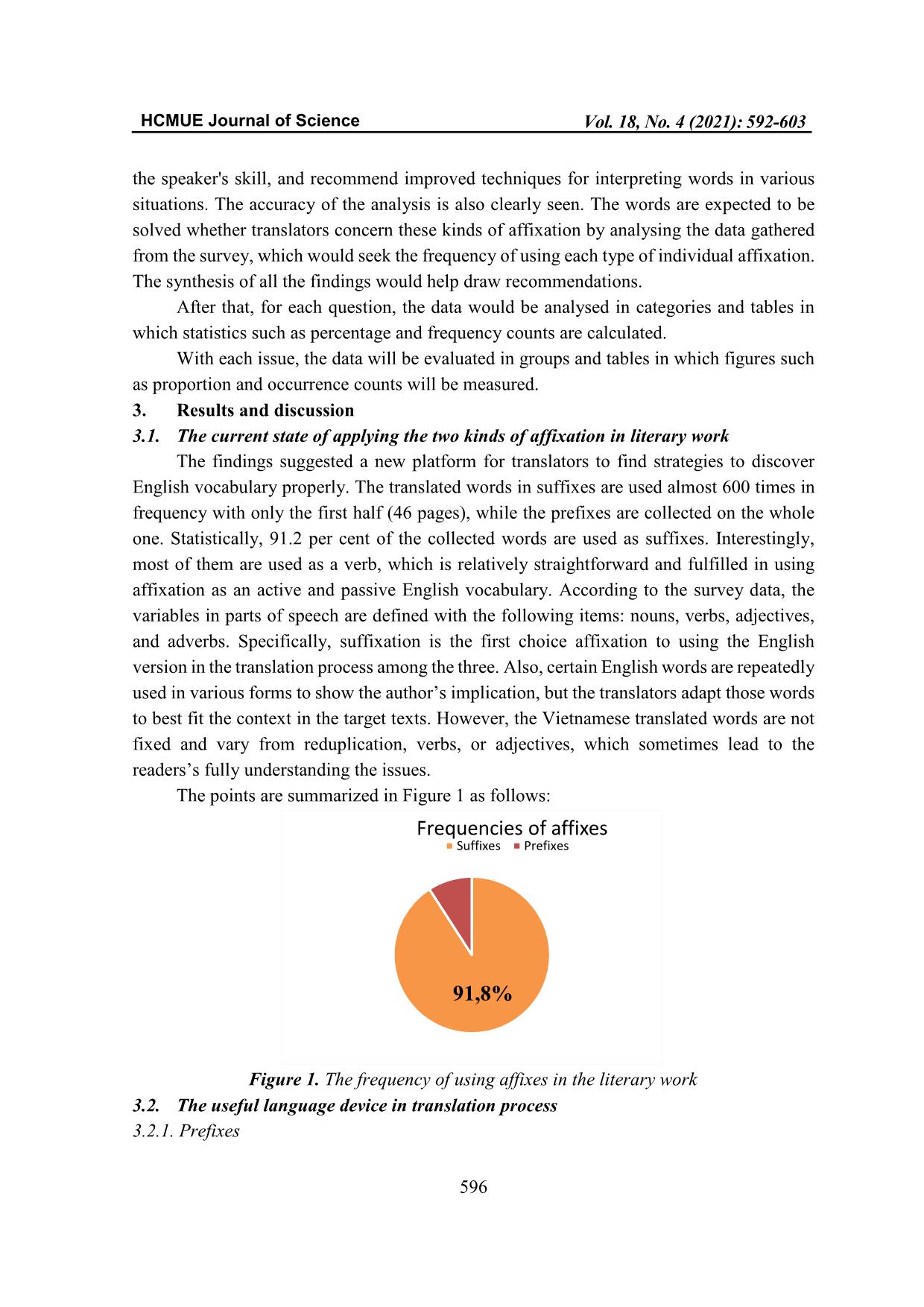
Trang 5

Trang 6
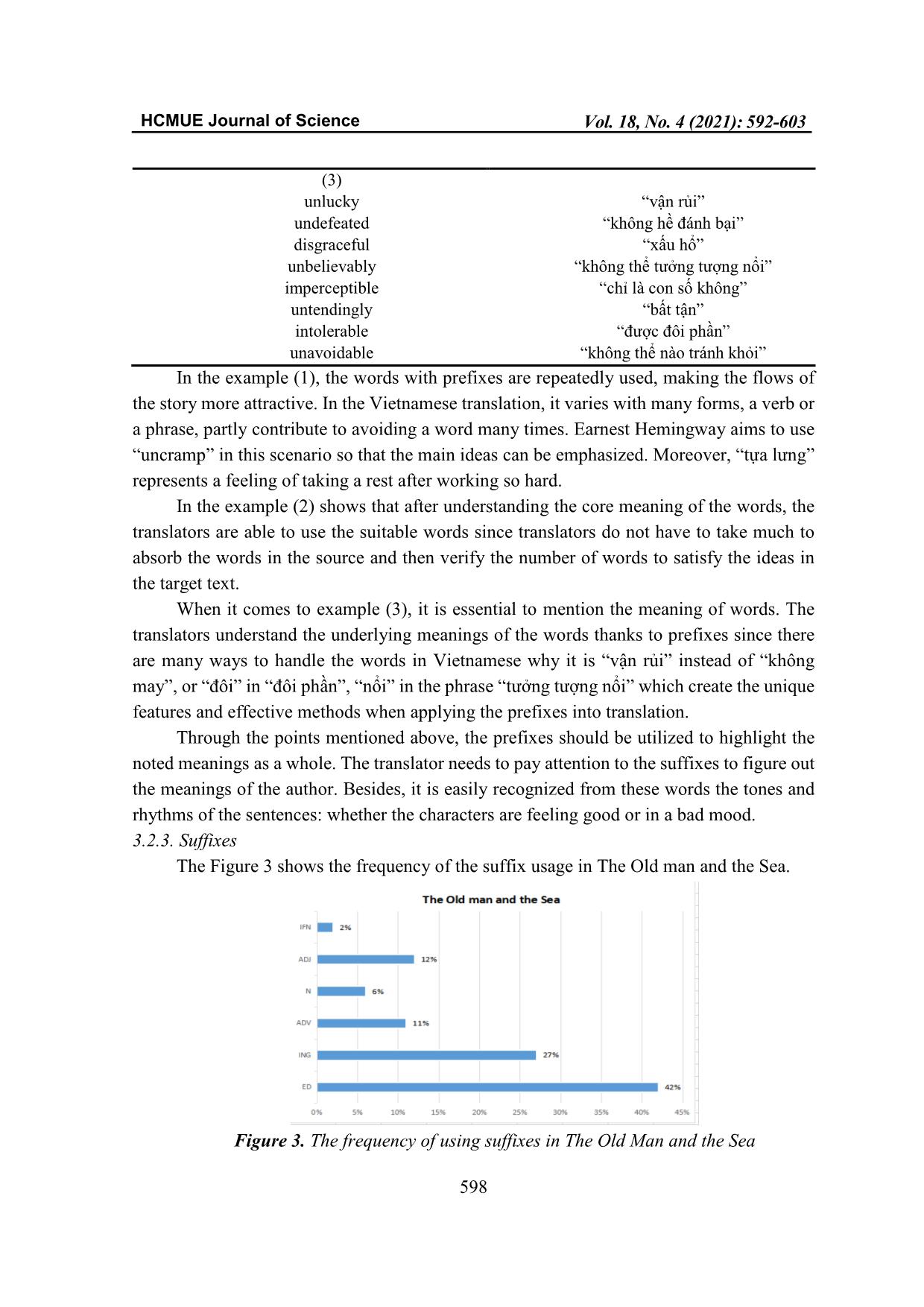
Trang 7

Trang 8

Trang 9
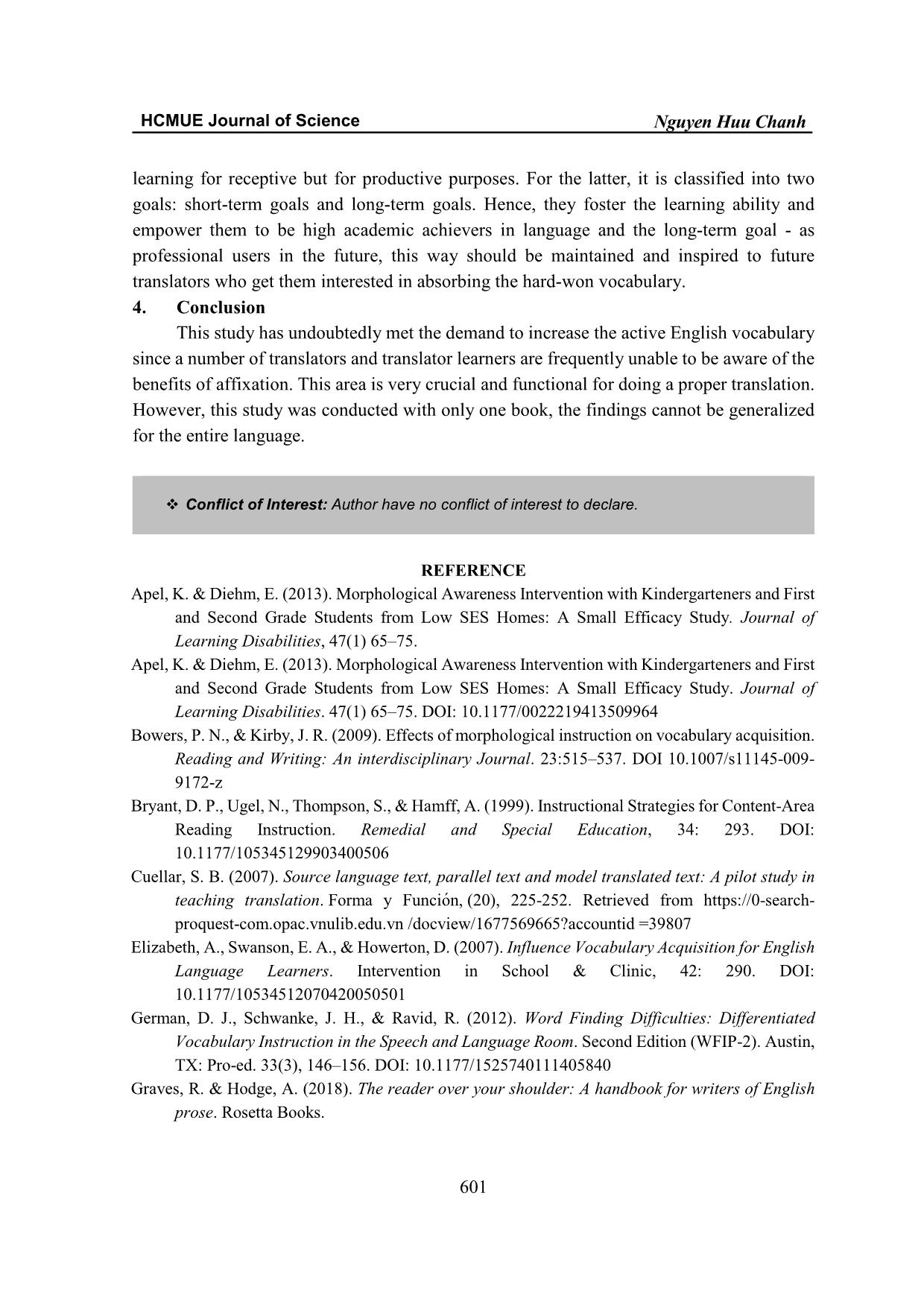
Trang 10
Tải về để xem bản đầy đủ
Tóm tắt nội dung tài liệu: Aiding the translation process with affixal analyis – A case study in “the old man and the sea”
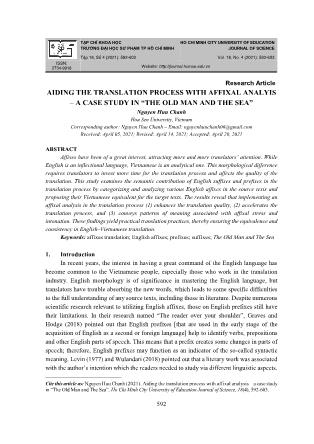
TẠP CHÍ KHOA HỌC TRƯỜNG ĐẠI HỌC SƯ PHẠM TP HỒ CHÍ MINH Tập 18, Số 4 (2021): 592-603 HO CHI MINH CITY UNIVERSITY OF EDUCATION JOURNAL OF SCIENCE Vol. 18, No. 4 (2021): 592-603 ISSN: 2734-9918 Website: 592 Research Article* AIDING THE TRANSLATION PROCESS WITH AFFIXAL ANALYIS – A CASE STUDY IN “THE OLD MAN AND THE SEA” Nguyen Huu Chanh Hoa Sen University, Vietnam Corresponding author: Nguyen Huu Chanh – Email: nguyenhuuchanh06@gmail.com Received: April 05, 2021; Revised: April 14, 2021; Accepted: April 20, 2021 ABSTRACT Affixes have been of a great interest, attracting more and more translators’ attention. While English is an inflectional language, Vietnamese is an analytical one. This morphological difference requires translators to invest more time for the translation process and affects the quality of the translation. This study examines the semantic contribution of English suffixes and prefixes in the translation process by categorizing and analyzing various English affixes in the source texts and proposing their Vietnamese equivalent for the target texts. The results reveal that implementing an affixal analysis in the translation process (1) enhances the translation quality, (2) accelerates the translation process, and (3) conveys patterns of meaning associated with affixal stress and intonation. These findings yield practical translation practices, thereby ensuring the equivalence and consistency in English–Vietnamese translation. Keywords: affixes translation; English affixes; prefixes; suffixes; The Old Man and The Sea 1. Introduction In recent years, the interest in having a great command of the English language has become common to the Vietnamese people, especially those who work in the translation industry. English morphology is of significance in mastering the English language, but translators have trouble absorbing the new words, which leads to some specific difficulties to the full understanding of any source texts, including those in literature. Despite numerous scientific research relevant to utilizing English affixes, those on English prefixes still have their limitations. In their research named “The reader over your shoulder”, Graves and Hodge (2018) pointed out that English prefixes [that are used in the early stage of the acquisition of English as a second or foreign language] help to identify verbs, prepositions and other English parts of speech. This means that a prefix creates some changes in parts of speech; therefore, English prefixes may function as an indicator of the so-called syntactic meaning. Levin (1977) and Wulandari (2018) pointed out that a literary work was associated with the author’s intention which the readers needed to study via different linguistic aspects. Cite this article as: Nguyen Huu Chanh (2021). Aiding the translation process with affixal analysis – a case study in “The Old Man and The Sea”. Ho Chi Minh City University of Education Journal of Science, 18(4), 592-603. HCMUE Journal of Science Nguyen Huu Chanh 593 They stated that poetry, which included the language and some of the poetic sequences, was formulated by the grammar to convey the meanings and confirmed to contribute the ideas to the language analysis. That is why poetry constitutes to the description of sentences. While figuring out some related findings, the authors also considered the questions about the evaluation of the English grammar in terms of English morphology. They also mentioned the essence of a poem to support the above idea. The characteristic of being “enduring” appeared in the poetry, which was not merely stationary, instead, changing from one literary to another. They quoted the conclusion of Paul Valéry in his book “The art of poetry” (1938) that the identity among the poems was the noted feature, or formed into an explanation to display themselves in their way. Therefore, this study aims at researching the efficiency of English affixes with a focus on prefixes, in the view of semantics features to discover better rules enhancing the quality of translation, then drawing some insightful implications in translation training. In order to explore and have an insight view of the changing roles of teachers in this age, this qualitative study was conducted with the book “The Old Man and The Sea” with the specific following research questions: - RO1: How effectively do English -Vietnamese translators take advantages of affixes in translation process? - RO2: How are affixes used in the target texts? 2. Literature review and Methodology 2.1. Literature review 2.1.1. Some basic concepts As regards forming a new word, there are two categories, namely derivation and inflection. For example, Figure 1 shows that the part of speech is changed or unchanged when attaching a prefix regardless of the difference in meanings. Table 1 presents an example on suffix PRE_ (according to Cambridge dictionary) as follows: Table 1. Diagram of how the words stayed the same in terms of prefixes Prefix Part of Speech Maintenance PRE_ Historic (adj) Prehistoric (adj) Important or likely to be important in history Describing the period before there were written record Hyper_ Tension (noun) Hypertension (n) A feeling of nervousness before an important or difficult event A medical condition in which your blood pressure is extremely high “Prehistoric” is formed by the base morpheme “historic” and the bound morpheme suffix “-pre”. The category of “historic” is an adjective while “-pr” is a prefix. The prefix “- HCMUE Journal of Science Vol. 18, No. 4 (2021): 592-603 594 pre” creates the grammatical form from the same verb with the same part of speech. It is called the inflectional prefix of an adjective (Adjectival prefixes). “Hypertension” is the word that constituted from the base morpheme “tension” and the bound mo ... able “vận rủi” “không hề đánh bại” “xấu hổ” “không thể tưởng tượng nổi” “chỉ là con số không” “bất tận” “được đôi phần” “không thể nào tránh khỏi” In the example (1), the words with prefixes are repeatedly used, making the flows of the story more attractive. In the Vietnamese translation, it varies with many forms, a verb or a phrase, partly contribute to avoiding a word many times. Earnest Hemingway aims to use “uncramp” in this scenario so that the main ideas can be emphasized. Moreover, “tựa lưng” represents a feeling of taking a rest after working so hard. In the example (2) shows that after understanding the core meaning of the words, the translators are able to use the suitable words since translators do not have to take much to absorb the words in the source and then verify the number of words to satisfy the ideas in the target text. When it comes to example (3), it is essential to mention the meaning of words. The translators understand the underlying meanings of the words thanks to prefixes since there are many ways to handle the words in Vietnamese why it is “vận rủi” instead of “không may”, or “đôi” in “đôi phần”, “nổi” in the phrase “tưởng tượng nổi” which create the unique features and effective methods when applying the prefixes into translation. Through the points mentioned above, the prefixes should be utilized to highlight the noted meanings as a whole. The translator needs to pay attention to the suffixes to figure out the meanings of the author. Besides, it is easily recognized from these words the tones and rhythms of the sentences: whether the characters are feeling good or in a bad mood. 3.2.3. Suffixes The Figure 3 shows the frequency of the suffix usage in The Old man and the Sea. Figure 3. The frequency of using suffixes in The Old Man and the Sea HCMUE Journal of Science Nguyen Huu Chanh 599 The most frequently used by the translator is -ed form while there are few of the bare form of infinitives, which means that the style of Earnest Hemingway is using the -ed form to express the meanings. Table 4 gives information on Vietnamese - English comparison of affixes. Table 4. The Vietnamese - English version to show the flexibility of using suffixes Source test (English version) Target text (Vietnamese one) Words in different parts of speech [...] He loved green turtles and hawls-bills with their elegance and speed and their value and he had a friendly contempt [] [...] Lão yêu giống rùa xanh, lưng khòm, duyên dáng, nhanh nhẹn và giá trị lớn của chúng và lão có tình cảm suồng sã theo kiểu bạn bè [] Words within a sentence that contribute to the meaning [...] the female fish had stayed by the side of the boat [] [...] He was beautiful, the old man remembered, and he had stayed [] --- [...] Then he rested against the bow. He rested sitting on the un-stepped mast [] [...] con cá đực vẫn cứ sán lại bên mạn thuyền [] [...] Nó thật đẹp, ông lão nhớ, và nó thủy chung [] --- [...] Rồi lão tựa lưng vào mũi thuyền. Lão ngồi nghỉ trên đống cột buồn chưa dựng [] Words expressed in the source text and the target text loved politely happily naturally quietly motionless desperately circled wildly cheerfully falsest harshness widens added tired promptly quý từ tốn hanh phúc rõ rồi khẽ bất động bất động bay vòng loạn xạ háo hức man trá sự nghiệt ngã ấy nới rộng thêm tăng thấm mệt vội The first illustration shows that "elegance" is a noun, but it turns into an adjective with the reduplication form in the target text to describe the person's characteristics. Besides, "suồng sã" is used here with a purpose. In Vietnamese, it means to express the actions related to each other, that is, to display the relationship between the character and the fish. In this case, the meaning is straightforward when analyzing "friend" as a noun and "friendly" as an HCMUE Journal of Science Vol. 18, No. 4 (2021): 592-603 600 adjective. Those who are not able to identify the Vietnamese words also understand the meanings here. Furthermore, the translator also does not need to spend so much time searching for the purpose, which significantly improves the speed of translation. In the example (2), one word is used in similar parts of speech in English, but the Vietnamese forms are different, ranging from verb (tựa lưng, ngồi nghỉ, sán) to an adjective (thủy chung). Therefore, with just a word, a translator can quickly know the writer's meaning and purpose so that the right ideas can be transferred into the target text. Besides, "thủy chung" is a beautiful word that indicates a very satisfying affection between human beings and the fish. In example (3), thanks to suffixes, translators have a better way to select the most meaningful words in Vietnamese. Some of them are “vội,” “thấm mệt,” “sự nghiệt ngã ấy,” etc. With the words "ấy" and "thấm" or some reduplications like "háo hức," the readers can effectively understand the context and the mood of the whole story, which is close to Vietnamese style and culture. Overall, this suffix is the best selected kind of affixes to help the translator achieve and digest the English vocabulary effectively in the translation process. Hence, it can be said that translators should take advantage of prefixation to improve translation quality. It is understandable because suffix is more accessible than the other options. 3.2.4. Improvement in translation’s quality From the number of prefixes utilized within the book, the study showed that the translators are not aware of the usefulness of prefixes in the translation process because they focus on other strategies given by the professionals. If there is an environment to develop translating ability in this area, more and more words will be achieved when considering affixation. Besides, the study shows that by using affixation, translators are not only able to learn a word itself but also discover other aspects. Parts of speech is the first one for learning affixation. Each prefix has its role as an adjective or a verb, and so on when attached to another stem. The second thing is the meaning. Every affix brings its meaning with a particular rule. Therefore, we can learn as many words as we can. In terms of affection, we can realize the word's stress because it is usual that the affixes are attached before the primary stress of a word, which is one of the principal findings. 3.2.5. More advantages of getting meanings from words Although this aspect is quite tricky since translators do not generally have time to take each piece of words to divide them into each category, and there are other things that they need to consider, it is still necessary to make a connection between word formation and translation. In other words, there must be an adaptation of the translating process and learning affixation. For the former, it plays a vital role. Affixes can motivate translators to learn English vocabulary efficiently as well as empower them to have a proper awareness, not HCMUE Journal of Science Nguyen Huu Chanh 601 learning for receptive but for productive purposes. For the latter, it is classified into two goals: short-term goals and long-term goals. Hence, they foster the learning ability and empower them to be high academic achievers in language and the long-term goal - as professional users in the future, this way should be maintained and inspired to future translators who get them interested in absorbing the hard-won vocabulary. 4. Conclusion This study has undoubtedly met the demand to increase the active English vocabulary since a number of translators and translator learners are frequently unable to be aware of the benefits of affixation. This area is very crucial and functional for doing a proper translation. However, this study was conducted with only one book, the findings cannot be generalized for the entire language. Conflict of Interest: Author have no conflict of interest to declare. REFERENCE Apel, K. & Diehm, E. (2013). Morphological Awareness Intervention with Kindergarteners and First and Second Grade Students from Low SES Homes: A Small Efficacy Study. Journal of Learning Disabilities, 47(1) 65–75. Apel, K. & Diehm, E. (2013). Morphological Awareness Intervention with Kindergarteners and First and Second Grade Students from Low SES Homes: A Small Efficacy Study. Journal of Learning Disabilities. 47(1) 65–75. DOI: 10.1177/0022219413509964 Bowers, P. N., & Kirby, J. R. (2009). Effects of morphological instruction on vocabulary acquisition. Reading and Writing: An interdisciplinary Journal. 23:515–537. DOI 10.1007/s11145-009- 9172-z Bryant, D. P., Ugel, N., Thompson, S., & Hamff, A. (1999). Instructional Strategies for Content-Area Reading Instruction. Remedial and Special Education, 34: 293. DOI: 10.1177/105345129903400506 Cuellar, S. B. (2007). Source language text, parallel text and model translated text: A pilot study in teaching translation. Forma y Función, (20), 225-252. Retrieved from https://0-search- proquest-com.opac.vnulib.edu.vn /docview/1677569665?accountid =39807 Elizabeth, A., Swanson, E. A., & Howerton, D. (2007). Influence Vocabulary Acquisition for English Language Learners. Intervention in School & Clinic, 42: 290. DOI: 10.1177/10534512070420050501 German, D. J., Schwanke, J. H., & Ravid, R. (2012). Word Finding Difficulties: Differentiated Vocabulary Instruction in the Speech and Language Room. Second Edition (WFIP-2). Austin, TX: Pro-ed. 33(3), 146–156. DOI: 10.1177/1525740111405840 Graves, R. & Hodge, A. (2018). The reader over your shoulder: A handbook for writers of English prose. Rosetta Books. HCMUE Journal of Science Vol. 18, No. 4 (2021): 592-603 602 Gérard, G. (1997). Paratexts: thresholds of interpretation. Cambridge: The University of Cambridge. pp. 1–2. ISBN 9781107784321. OCLC 867050409. Retrieved from https://books.google.com.vn/books?id= AmWhQzemk2EC&pg=PR18&redir_esc =y#v=onepage&q&f=false Honig, B. et al. (2000). Teaching Reading Sourcebook: For Kindergarten Through Eighth Grade. Novato, CA: Arena Press. Hemingway, E. (2019). The Old Man and the Sea (Ông già và biển cả – translated by Le Huy Bac). Ho Chi Minh General Publishing House. Levin, S. R. (1977). Linguistic structures in poetry. Mouton Publishers, The Netherlands Lieber, R. (2009). Introducing Morphology. Lexeme formation: the familiar. Cambridge: Cambridge University Press. McArthur, T. (1992). The Oxford Companion to the English Language. Oxford: Oxford University Press. Michońska-Stadnik, A. (2013). Awareness of Derivational Morphology and its Influence on Vocabulary Retention: Investigations in Teaching and Learning Languages. Second Language Learning and Teaching. 10.1007/978-3-319-00044-2_8 Murray, B. A., & Steinen, N. (2011). Word/map/ping: How Understanding Spellings Improves Spelling Power. Intervention in School & Clinic, 46: 299. DOI: 10.1177/1053451210395388 Payne, T. (1997). Describing Morphosyntax: A Guide for Field Linguists. Cambridge: Cambridge University Press. Retrieved from Payne, D. (2008). Web Lecture 1.4: Suffixes and Prefixes. Oregon: University of Oregon. Plag, I. (2002). Word Formation in English. Cambridge: Cambridge University Press. Reiss, K. (1971). Möglichkeiten und Grenzen der Übersetzungskritik. München: Max Hueber Verlag. Erroll F. Rhrodes (Trad. Ing.), (2000). Translation Criticism –The potentials and Limitations. Categories and Criteria for Translation Quality Assessment. New York/ Manchester, American Bible Society/ St. Jerome Publishing. Reeves, J. (2010). Teacher learning by script. Language Teaching Research, 14(3) 241–258. DOI: 10.1177/1362168810365252 Spies, T. G., & Dema, A. A. (2013). Beyond Word Meaning: Vocabulary Instruction for Students with Exceptional Language Needs. Intervention in School & Clinic, 49(5) 271–280. DOI: 10.1177/1053451213513798 Tucci, S. L., Trussell, J. W., & Easterbrooks, S. R. (2014). A Review of the Evidence on Strategies for Teaching Children Who Are DHH. Grapheme–Phoneme Correspondence. Communication Disorders Quarterly, 35(4), 191–203. DOI: 10.1177/1525740114523776 Zuba, J. (2016). Conclusion: Making Introductions. In The First Book: TwentiethCentury Poetic Careers in America (pp. 154-168). PRINCETON; OXFORD: Princeton University Press. Retrieved from HCMUE Journal of Science Nguyen Huu Chanh 603 HỖ TRỢ QUÁ TRÌNH DỊCH THUẬT BẰNG VIỆC PHÂN TÍCH PHỤ TỐ – MỘT NGHIÊN CỨU Ở TÁC PHẨM “ÔNG GIÀ VÀ BIỂN CẢ” Nguyễn Hữu Chánh Trường Đại học Hoa Sen, Việt Nam Tác giả liên hệ: Nguyễn Hữu Chánh – Email: nguyenhuuchanh06@gmail.com Ngày nhận bài: 05-4-2021; ngày nhận bài sửa: 14-4-2021; ngày duyệt đăng: 20-04-2021 TÓM TẮT Phụ tố đã được nhiều người quan tâm, ngày càng thu hút nhiều dịch giả. Trong khi tiếng Anh là một ngôn ngữ biến hình, thì tiếng Việt là một ngôn ngữ cách thể. Sự khác biệt về hình thái này dẫn đến tăng thời gian của quá trình dịch và giảm chất lượng của văn bản đích. Bài viết xem xét sự đóng góp về mặt ngữ nghĩa của các hậu tố và tiền tố tiếng Anh trong quá trình dịch bằng cách phân loại và phân tích các phụ tố tiếng Anh khác nhau trong các văn bản nguồn và đề xuất tương đương tiếng Việt ở văn bản đích. Kết quả cho thấy việc thực hiện phân tích phụ tố trong quá trình dịch (i) nâng cao chất lượng bản dịch, (ii) đẩy nhanh quá trình dịch, và (iii) truyền tải các mẫu ý nghĩa liên quan đến trọng âm và ngữ điệu của phụ tố. Những phát hiện này mang lại sự đóng góp cho các hoạt động dịch thuật thực tế, do đó đảm bảo tính tương đương và nhất quán trong bản dịch Anh – Việt. Từ khóa: dịch phụ tố; phụ tố tiếng Anh; tiền tố; hậu tố; Ông già và biển cả
File đính kèm:
 aiding_the_translation_process_with_affixal_analyis_a_case_s.pdf
aiding_the_translation_process_with_affixal_analyis_a_case_s.pdf

